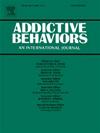Adolescent extraversion and agreeableness predict adult alcohol use: A 22-Year prospective study
IF 3.7
2区 医学
Q1 PSYCHOLOGY, CLINICAL
引用次数: 0
Abstract
The Five Factor Model (FFM or Big 5) traits of extraversion, agreeableness, conscientiousness, neuroticism and openness, have all been associated with alcohol use. However, the vast majority of these studies have used cross-sectional designs, limiting the ability to evaluate the temporal relationships between childhood personality traits in adult alcohol use patterns.
In the current prospective community cohort study (N = 329), we examine the predictive value of FFM traits measured in childhood and adolescence (starting at 6–9 years of age; well before the typical age at which adolescents begin drinking) for alcohol use in adulthood (27–30 years of age), spanning an average of 22 years. Personality was assessed with the Hierarchical Personality Inventory for Children (HiPIC) across 5 consecutive waves utilizing multiple informants (child, mother, father, and teachers). Alcohol use was measured by the self-report Quantity-Frequency Variability Index (QFV).
A series of regression analyses indicates that during adolescence, high levels of extraversion and low levels of agreeableness are both (independently) associated with heavier drinking. These associations are robust and consistent from the first adolescent wave (age 12–15 years) to the last adolescent wave. Notably, informant-dependent measures from early childhood waves (ages 6–9) were not significant predictors, highlighting the importance of considering developmental context and informant variability. By leveraging a longitudinal design with temporally separated measures of personality and alcohol use, this study minimizes concerns about reverse causality. The results highlight the long-term relevance of adolescent personality traits in understanding adult drinking behavior and suggest that targeted prevention strategies focusing on highly extraverted and low-agreeable adolescents may help reduce harmful drinking patterns later in life.
求助全文
约1分钟内获得全文
求助全文
来源期刊

Addictive behaviors
医学-药物滥用
CiteScore
8.40
自引率
4.50%
发文量
283
审稿时长
46 days
期刊介绍:
Addictive Behaviors is an international peer-reviewed journal publishing high quality human research on addictive behaviors and disorders since 1975. The journal accepts submissions of full-length papers and short communications on substance-related addictions such as the abuse of alcohol, drugs and nicotine, and behavioral addictions involving gambling and technology. We primarily publish behavioral and psychosocial research but our articles span the fields of psychology, sociology, psychiatry, epidemiology, social policy, medicine, pharmacology and neuroscience. While theoretical orientations are diverse, the emphasis of the journal is primarily empirical. That is, sound experimental design combined with valid, reliable assessment and evaluation procedures are a requisite for acceptance. However, innovative and empirically oriented case studies that might encourage new lines of inquiry are accepted as well. Studies that clearly contribute to current knowledge of etiology, prevention, social policy or treatment are given priority. Scholarly commentaries on topical issues, systematic reviews, and mini reviews are encouraged. We especially welcome multimedia papers that incorporate video or audio components to better display methodology or findings.
Studies can also be submitted to Addictive Behaviors? companion title, the open access journal Addictive Behaviors Reports, which has a particular interest in ''non-traditional'', innovative and empirically-oriented research such as negative/null data papers, replication studies, case reports on novel treatments, and cross-cultural research.
 求助内容:
求助内容: 应助结果提醒方式:
应助结果提醒方式:


